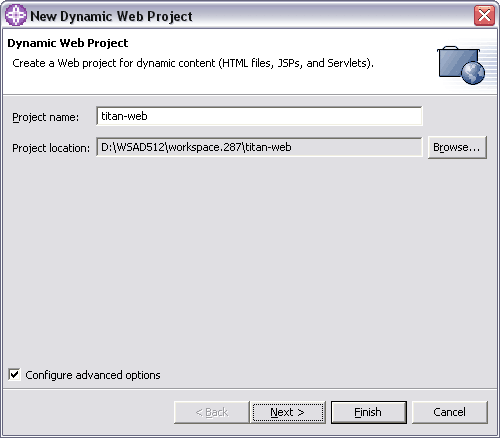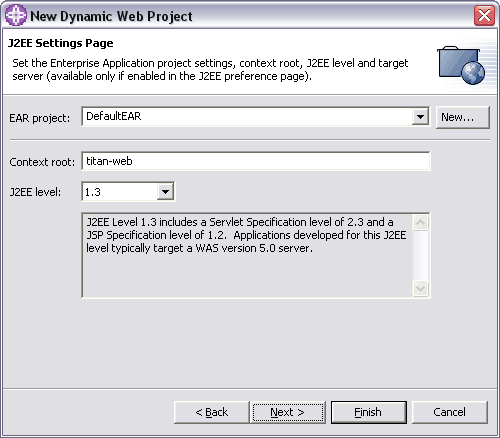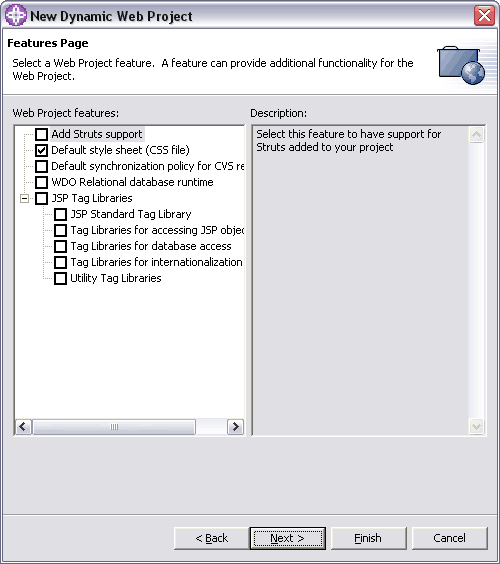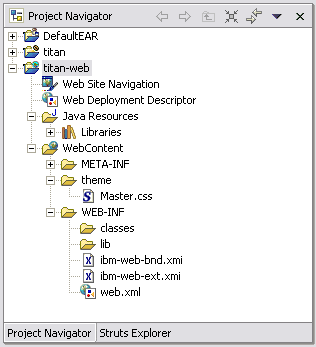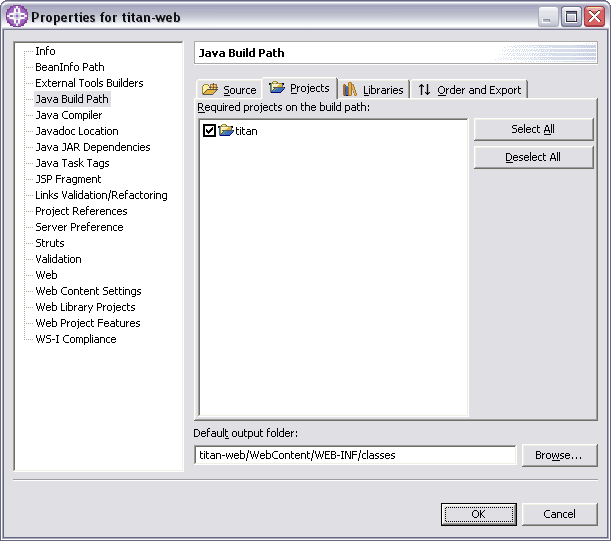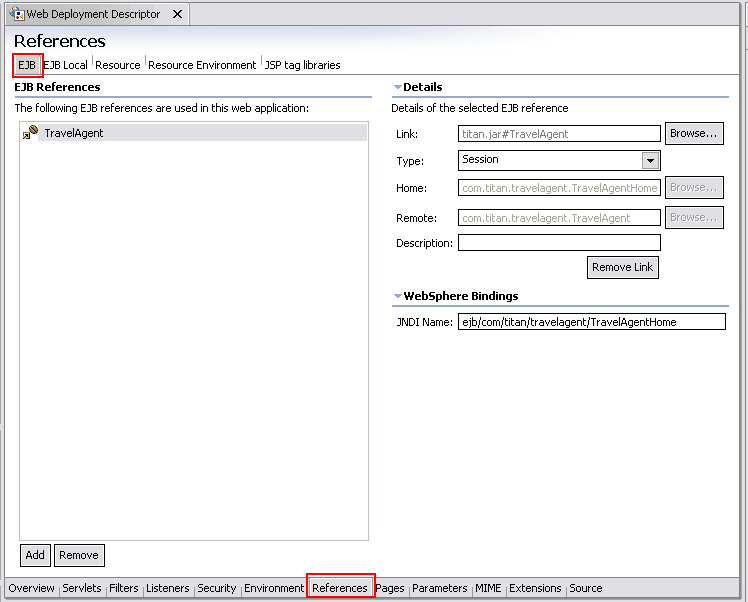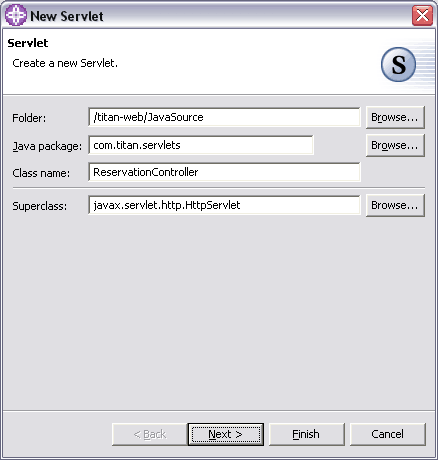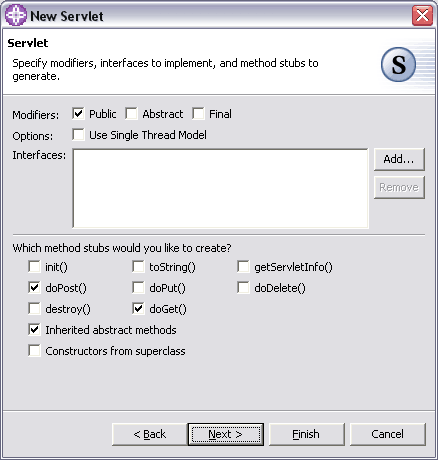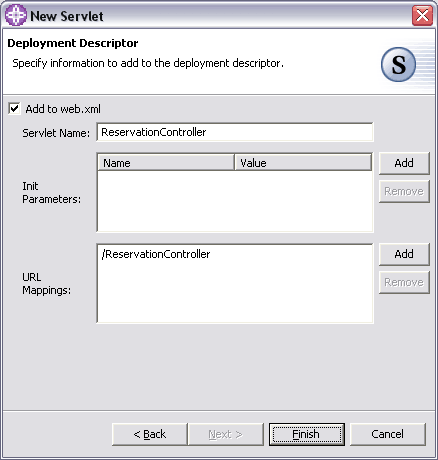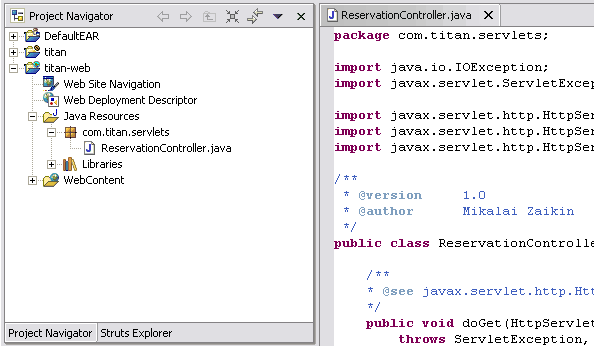Design, develop and test Java Servlets, filters and listeners
Creating a dynamic Web project
You create and maintain the resources for your Web applications in Web projects. Dynamic Web projects enable
you to create resources such as JavaServer Pages and servlets, and use technologies such as Struts and
JavaServer Faces.
Note: If you want to specify a target server for the Web project you are going to create, you should first
enable server targeting support on the J2EE preferences page.
To create a new dynamic Web project:
Click File > New > Project. Then select the
Web option on the left, the
Dynamic Web Project option on the right, and then click
the Next button. The
New Dynamic Web Project wizard is launched.
Provide a name for the Web project (titan-web).
Accept the default value in the Project location field (this is
where your project is stored in your file system), or click Browse to
choose a location from the file system.
To specify or customize the project options, select the
Configure advanced options check box and
click Next.
Note that you would also select this option if you wanted to add Struts support to your Web
project. Also note that if you wanted to accept the defaults associated with a dynamic Web
project, you would leave Configure advanced options unchecked and
click Finish. This would create an Enterprise
Application project
(EAR file) named DefaultEAR in the same directory as your new Web project.
A new or existing Enterprise Application project must be associated with your new Web project to
facilitate deployment. If you selected Configure advanced options and
then clicked Next, the J2EE Settings Page
appears in which you can customize the project options:
If the Enterprise Application project is new, click New and then
type a name for the new project. When your Web project is created at the end
of the wizard, the new Enterprise Application project is also created with the same name
as the project. Note that the default is an EAR file named DefaultEAR
located in the same directory as your new Web project.
If the Enterprise Application project already exists, select the project from
the EAR project drop down list.
Note: If you want to add a Web project as a module to another Enterprise Application project in the
future, you can open the application deployment descriptor editor for the Enterprise Application project and
select the Add option in the General page.
Provide a Context root value. The context root is the
Web application root, the top-level directory of your application when it is deployed to a Web
server. You can change the context root after you create a project using the project
Properties dialog, which you access from the project's context menu.
The context root can also be used by the links builder to ensure that your links remain ready to publish
as you move and rename files inside your project.
From the J2EE Level drop-down list, select the appropriate Sun
Microsystems Servlet and JSP specification level for the dynamic elements you plan to include
in your Web project.
Any new servlets and JSP files that you expect to create should adhere to the latest specification level
available; previous specification levels are offered to accommodate any legacy dynamic elements that
you expect to import into the project.
By default, the Web project's J2EE level is set to the Workbench's J2EE level. Project preferences
are initialized when the project is created. If you want to update these preferences, do the following:
Select Window > Preferences > J2EE
Choose the appropriate J2EE level from the J2EE property settings.
If you choose to create a new Enterprise Application project for this Web project, the J2EE
level setting controls the level of the resulting EAR file as well.
Check Use the same target server as the EAR Project. You
must target the same server for both the Web and EAR project in order to deploy your Web
application to the server properly. However, if you want to specify a different server for
your Web project, in the Target server drop-down menu,
select the application server that you want to target. This can be useful if the
same Web project is included in two
different EAR projects, each targeting different
servers.
Click Next.
Select one or more of the Web Project features. The box on the
right displays a description of each feature as you select it on the left. The default feature
is, Default style sheet (CSS file). Accepting the default creates
a default CSS file called Master.css, which is used for any HTML
and JSP files included in the project. (Note that the next step assumes you have selected
this option)
If you want to create a project that uses Struts technology, select Add Struts
support and click Next; the Struts Settings
page appears. You can specify the version of Struts technology you want to use in your project, the
package prefix, and whether or not you want to bundle the resources.
Note: The Add Faces Base Components and
WDO Relational database runtime options are available
on the Features Page; however, you are not required to select
these features when you create your Web project. If you add any
Faces resources to your Web project, the Faces tooling will automatically
be enabled.
Click Next.
Select Use a default Page Template for the Web Site if you want your
entire Web site to share a common page template. If you want to use one of the sample templates provided,
select Sample Template and then choose one of the templates shown
in the Thumbnail box. If you want to use a template of your
own, select User-defined Template and then click
Browse to select the template from the file system.
Click Finish. The wizard creates a new project that reflects the
J2EE folder structure that specifies the location of web content files, class files, class paths, the
deployment descriptor, and supporting metadata.
You can now begin creating or importing content for your Web project using Web Site Designer, Web resource editors (such
as Page Designer), the New File wizards, or the Import wizards available from the File menu.
Viewing and editing a project's Java build path
A project's Java build path can either be defined when creating the project with the
New Wizard or later in the project's property dialog.
The Java build path settings dialog is the same in both cases. To view and edit a project's
Java build path, follow these steps:
0
Select the project you want to view or edit (titan-web).
From the project's pop-up menu, select Properties.
Select the Java Build Path page.
1
Define the source entries for the build path on the Source page:
On the Projects page, identify the other projects that are required for
building this project (titan).
The list shows all the existing Java projects from the workbench.
2
NOTE: Each selected project is automatically added to the list of referenced projects.
On the Libraries page, define the libraries required by your
project. Libraries come in different forms. There are buttons for adding a library in each form.
By default, each Java project has a 'JRE System Library' entry on the build path. This entry
stands for the workbench's default JRE.
On the Order and Export page, define the Java build path
order. The recommended ordering is to have source entries before the library entries
and the required projects.
3
Working in the References page in the deployment descriptor editor
The References page in the Web deployment descriptor editor lets you add or
remove references to EJBs (Enterprise Java Beans) in the deployment descriptor. This page also lets you add
or remove references to resources, resource environments, and JSP tag libraries.
To work with the References page of the Web deployment descriptor editor:
4
Open a Web project in the Project Navigator.
Double-click the Web project's Web Deployment Descriptor file in
the Project Navigator. The Web deployment descriptor editor opens.
Click the References tab to open the
References page.
5
Click one of the following tabs within the References page:
EJB tab - lets you add or remove references to EJBs used in the application. You can
provide a name for the reference (TravelAgent), a link to
an enterprise bean in the current module or another module within the application,
an EJB type (such as Session or Entity), the fully qualified name of the
home interface, the fully qualified name of the remote interface, and
a description. You can also enter the JNDI (Java Naming and Directory Interface) name
that the servlet code uses to get
a reference to an enterprise bean
(ejb/com/titan/travelagent/TravelAgentHome):
env = (Context) new InitialContext();
home = env.lookup("ejb/com/titan/travelagent/TravelAgentHome");
agentHome = (TravelAgentHome) PortableRemoteObject.narrow(home, TravelAgentHome.class);
EJB Reference added to web.xml:
<web-app id="WebApp">
...
<ejb-ref id="EjbRef_1124278200583">
<ejb-ref-name>TravelAgent</ejb-ref-name>
<ejb-ref-type>Session</ejb-ref-type>
<home>com.titan.travelagent.TravelAgentHome</home>
<remote>com.titan.travelagent.TravelAgent</remote>
<ejb-link>titan.jar#TravelAgent</ejb-link>
</ejb-ref>
</web-app>
EJB Local tab - lets you add or remove EJB local references to EJBs used in the
application. The fields are similar to the ones in the EJB tab.
6
Resource tab - lets you add or remove resource references used in the application. You
can also list and change details about the selected resource (including the Java Class
type, the user roles that should be permitted to access specific resource collections),
WebSphere Extensions (connection management and the level of transactional isolation),
and WebSphere Binding information (the JNDI (Java Naming and Directory Interface) name
that the servlet code uses to get a reference to an enterprise bean).
Resource Environment tab - lets you add or remove resource environment references used
in the application. The fields are similar to the ones in the Resource tab.
JSP tag libraries tab - lets you add or JSP tag library references used in the application.
You can also specify the location of each tag library.
7
Creating servlets
The Servlet wizard walks you through the process of creating Java servlets, step-by-step, and provides you
with output files you can use "as is" or modify for your Web application. The resulting servlets run on
the WebSphere Application Server or other J2EE-compliant Web server, and provide server-side processing for
dynamic content.
To create a servlet, do the following:
8
To launch the Servlet wizard, from the Web perspective select File > New > Servlet.
In the Create a new Servlet page, supply the following:
Specify the folder where the servlet class will be placed, the package
that the class will
belong to (it is added into a default package if you do not specify one), and a name for
the servlet. The Class name value should be the class name
of the servlet. You should place the servlet in the Java source folder.
9
Folder - /titan-web/JavaSource
Java package - com.titan.servlets
Class name - ReservationController
0
Specify a superclass for the servlet class. A servlet created by this wizard can have
HttpServlet, or any class that has
HttpServlet in its hierarchy, as its superclass. Click
Browse to choose from the available
superclasses.
Click Next.
Select a modifier to specify whether your servlet class is public,
abstract, or final. (Classes cannot be both
abstact and final.)
1
Specify whether the servlet you create implements the SingleThreadModel interface
by selecting the Use Single Thread Model option. This guarantees
that there will not be simultaneous access to the same servlet instance, which has a tendency to
stabilize thread execution ordering.
The javax.servlet.Servlet is provided as the default
Interface. You can also add additional interfaces to implement.
Click Add... to open the
Interface Selection dialog. In this dialog, as
you type the name of the interface that you are interested in adding in the
Choose interfaces field, the list of available interfaces listed in the
Matching types list box updates dynamically to display only the
interfaces that match the pattern. Choose an interface to see the
Qualifier and click Add.
Click OK when you are finished.
Select any appropriate method stubs to be created in the servlet file. The stubs created by using
the Inherited abstract methods option must be implemented if you
do not intend to create an abstract servlet. This is not true for
Constructors from superclass.
2
Click Next.
If you select the Add to web.xml check box, the servlet, along with its
display name, and any URL mappings and initialization parameters associated with the servlet
will be automatically included in the Web project web.xml file. Note that the
Class name value provided in the first page of the wizard
is automatically mapped on this page. The mapping is updated if you change the value in
the Servlet Name field.
Click Finish.
3
The servlet is generated. To run the generated servlet, launch the WebSphere test environment.
Add the following code to the ReservationController servlet:
public void doGet(HttpServletRequest req, HttpServletResponse resp) throws ServletException, IOException {
doPost(req, resp);
}
public void doPost(HttpServletRequest req, HttpServletResponse resp) throws ServletException, IOException {
String firstName = req.getParameter("firstName");
String lastName = req.getParameter("lastName");
String cruise = req.getParameter("cruise");
Context env = null;
TravelAgent agent = null;
TravelAgentHome agentHome = null;
Object home = null;
try {
env = (Context) new InitialContext();
home = env.lookup("ejb/com/titan/travelagent/TravelAgentHome");
} catch (NamingException ne) {
log("ReservationController: can not lookup TravelAgentHome", ne);
try {
env.close();
} catch (NamingException e) {
log("ReservationController: can not close JNDI Context", e);
}
}
agentHome = (TravelAgentHome) PortableRemoteObject.narrow(home, TravelAgentHome.class);
try {
agent = (TravelAgent) agentHome.create();
} catch (CreateException ce) {
log("ReservationController: can not create TravelAgent", ce);
}
agent.sendReservation(firstName, lastName, cruise);
RequestDispatcher dispatch = req.getRequestDispatcher("/index.jsp");
dispatch.forward(req, resp);
}
Add the following code to the com.titan.travelagent.TravelAgent interface:
4
public void sendReservation(String firstName, String lastName, String cruise) throws java.rmi.RemoteException;
Add the following code to the com.titan.travelagent.TravelAgentBean class:
public void sendReservation(String firstName, String lastName, String cruise) {
try {
ic = new javax.naming.InitialContext();
qConnFactory = (javax.jms.QueueConnectionFactory) ic.lookup(fName);
queue = (javax.jms.Queue) ic.lookup(qName);
} catch (Exception e) {
System.err.println("TravelAgentBean: JNDI lookup failed " + e);
}
try {
qConn = qConnFactory.createQueueConnection();
qSession = qConn.createQueueSession(false, javax.jms.Session.AUTO_ACKNOWLEDGE);
qSender = qSession.createSender(queue);

